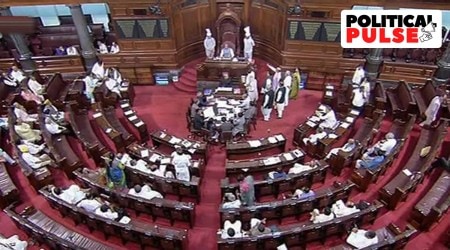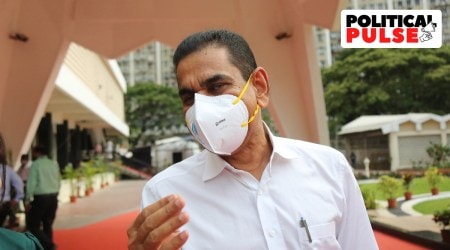India’s GDP grows at 8.7% in FY22, Q4 GDP rises 4.1%
[ad_1]
India’s economic growth slowed in the January-March period of 2021-22 to 4.1 per cent, a four-quarter low, reflecting in part the impact of the Omicron wave of the Covid-19 pandemic on the manufacturing sector and contact-intensive services. For the full financial year of 2021-22, the National Statistical Office marginally pruned its year-on-year gross domestic product (GDP) growth forecast to 8.7 per cent in the data released Tuesday, down from 8.9 per cent estimated in February. The economy had witnessed a 6.6 per cent contraction in 2020-21.
The fourth quarter GDP growth was lower than the 5.4 per cent growth seen in October-December quarter, but more than the 2.5 per cent growth rate in January-March 2021.
Buy Now | Our best subscription plan now has a special price
The GDP print for FY22 is significant as it shows growth in the recovery year after the onset of the Covid-19 pandemic in 2020. The latest GDP growth estimate is lower than the second advance estimate of 8.9 per cent (released on February 28) and first advance estimate of 9.2 per cent (released in January). For 2022-23, the Reserve Bank of India (RBI) has projected India’s GDP growth rate to be 7.2 per cent.
Among the eight key sectors, manufacturing was the only sector to record a contraction in the January-March quarter at -0.2 per cent, partly on account of the high base of 15.2 per cent during the fourth quarter of 2020-21. Manufacturing had recorded a growth of 0.3 per cent in the October-December quarter.
Agriculture continued to show buoyancy, recording a growth of 4.1 per cent in Q4, while mining & quarrying and construction sectors grew at 6.7 per cent and 2.0 per cent, respectively.
Chief Economic Adviser V Anantha Nageswaran said that the growth momentum of the economy “is intact”, although challenges remain from the continuing Russia-Ukraine war and tightening of monetary policies by developed countries. He said out of the 7 per cent retail inflation rate, about 2 per cent is coming from imported price pressures. With crude oil prices rising, inflationary pressures will remain elevated but the risk of stagflation “is quite low” for India compared to the rest of the world, he said.
As per data shared by him, all sectors in the economy showed higher recovery in FY22 from pre-Covid levels of FY20 except trade, hotels, and transport.
Inflation key risk to recovery
Consumption recovery remains uncertain amid high inflation and interest rates, which could temper the growth momentum in 2022-23. Silver lining: recovery in investment demand.
“Manufacturing drop is difficult to pinpoint; at this point I would like to attribute it to the effect of the Omicron variant, with lockdowns in several states, spilling over to February as well. The industrial production has indeed recovered in the course of the remaining months of the financial year and April as well. Therefore, at this point, I would say that probably it will turn out to be an aberration as far as contraction in manufacturing is concerned,” he said.
Private final consumption expenditure – a measure of consumption of goods and services by individuals – grew by 1.8 per cent year-on-year in Q4 of FY22. Gross fixed capital formation (GFCG) – a proxy for investment activity – grew by 5.1 per cent. Government final consumption expenditure provided support by growing at 4.8 per cent in January-March.
Gross Value Added — GDP minus net product taxes — grew at 8.1 per cent for FY22 as against a contraction of 4.8 per cent a year ago. The GDP in nominal terms, which factors in inflation, is seen growing 19.5 per cent as against a contraction of 1.4 per cent last year.
Separately released data for government accounts showed the fiscal deficit for 2021-22 worked out to be 6.71 per cent of the gross domestic product (GDP), lower than 6.9 per cent projected by the Finance Ministry in the revised Budget Estimates. Alo, the output of eight infrastructure sectors — coal, crude oil, natural gas, refinery products, fertiliser, steel, cement, and electricity — grew by 8.4 per cent in April against a 62.6 per cent expansion in the year-ago period, according to another dataset released on Tuesday. It had grown by 4.9 per cent in March.
DK Srivastava, Chief Policy Advisor, EY India said: “These numbers confirm that all GDP segments have emerged higher than their pre-COVID magnitudes. This is also true for all GVA sectors except the trade, hotels, transport, etc. In fact, in 4QFY22, all GDP and GVA segments have overtaken their corresponding 4QFY20 levels indicating that the Indian economy is well past the COVID shock.”
[ad_2]
Source link














